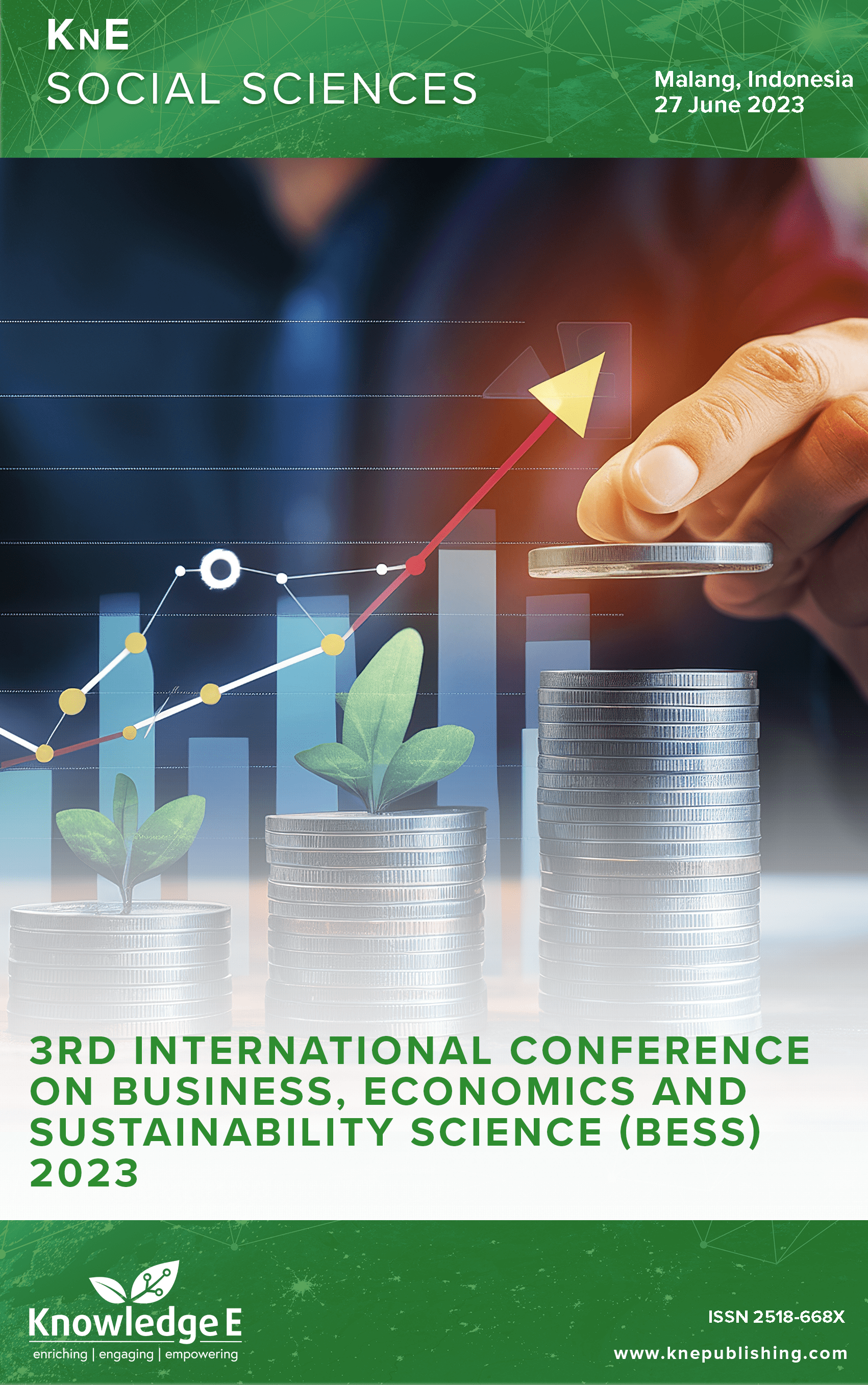Balancing Fund and Inclusive Economic Growth: East Java Provincial Study
DOI:
https://doi.org/10.18502/kss.v9i21.16762Abstract
One of the policies adopted by the government in development, especially in developing countries, is inclusive economic growth. This study examines how the effect of equalization funds as the main variables, as well as GDP per capita and open unemployment as control variables, on the Inclusive Economic Development Index (IDEI) as a proxy for inclusive economic growth. This research was conducted in 38 regencies/cities in East Java, in the period 2014-2020, using the PVECM Model as an analysis tool. In addition, this research also provides strategies and policy formulations in an effort to increase inclusive economic growth. The results show that in the long-term DAU and GDP per capita have a significant positive effect on inclusive development. Meanwhile, in the short term, DAK and GDP per capita have a positive insignificant effect. It can be concluded that the balancing fund supports inclusive economic development in East Java.
Keywords: intergovernmental transfer funds, inclusive economic development index, inclusive economic growth
References
Ahmad E. Intergovernmental transfers – an international perspective. In: Ahmad E, editor. Financing decentralized expenditures: an international comparison of grants. Cheltenham: Edward Elgar Publishers; 1997. https://doi.org/10.4337/9781035303403.00009 DOI: https://doi.org/10.4337/9781035303403
Ahmad S. Pengaruh pendapatan asli daerah, dana alokasi umum, dana alokasi khusus terhadap tingkat kemandirian daerah di Kota Makassar. Jurnal Ekonomika. 2021;5(1):17–37. DOI: https://doi.org/10.54259/ijba.v1i2.63
Aoyagi CG, Ganelli G. Asia’s quest for inclusive growth revisited. J Asian Econ. 2015;40:29–46. DOI: https://doi.org/10.1016/j.asieco.2015.06.005
Arina MM, Koleangan R A, Engka DS. Pengaruh pendapatan asli daerah, dana bagi hasil, dana alokasi umum, dan dana alokasi khusus terhadap pertumbuhan ekonomi Kota Manado. Jurnal pembangunan ekonomi dan keuangan daerah. 2021;20(3):26– 35. DOI: https://doi.org/10.35794/jpekd.23451.20.01.2019
Bappeda Jawa Timur. Ekonomi Jawa Timur tahun 2022 tumbuh 5,34 persen. Diakses pada 2 April 2023. jatimprov.go.id
BPS. Jawa Timur Dalam Angka 2023. Diakses pada 2 April 2023. https: //jatim.bps.go.id/publication/2023/02/28/446036fbb58d36b009212dbc/provinsijawa- timur-dalam-angka-2023.html
Easterly W. The tyranny of experts: economists, dictators, and the forgotten rights of the poor. Basic Books; 2014.
Elorhor OT. Unemployment and its effect on the growth of Nigeria economy. Journal of Economics, Management and Trade. 2019;23(2). https://doi.org/10.9734/jemt/2019/v23i230129 DOI: https://doi.org/10.9734/jemt/2019/v23i230129
Fahmi A. Keterkaitan antara penerimaan pajak penghasilan dan PBB terhadap kesenjangan pendapatan. JAK ( Jurnal Akuntansi) Kajian Ilmiah Akuntansi. 2019;6(1):39–54. DOI: https://doi.org/10.30656/jak.v6i1.945
Hiktaop K, Ulita AS, Meilvidiri W, Herdjiono MV, Hayon PP. Influence of fiscal decentralization on the economic growth of public welfare and poverty between regions of Province of Papua. IOP Conf Ser Earth Environ Sci. 2020;473(1):1–7. DOI: https://doi.org/10.1088/1755-1315/473/1/012030
Klasen S. Measuring and monitoring inclusive growth: multiple definitions, open questions, and some constructive proposals. Asian Development Bank; 2010.
Magdalena S, Suhatman R. The effect of government expenditures, domestic invesment, foreign invesment to the economic growth of primary sector in Central Kalimantan. Budapest International Research and Critics Institute-Journal (BIRCIJournal). 2020;3(3):1692–703. DOI: https://doi.org/10.33258/birci.v3i3.1101
Naveh M, Torosyan T, Jalaee SA. Regional economic integration and its effects on economic growth and economic welfare. World Appl Sci J. 2012;17(10):1349–55.
Nwankwo CA, Ifejiofor AP. Impact of unemployment on Nigerian economic development: a study of selected local government area in Anambra State, Nigeria. Eur J Bus Manag. 2014;6:103–12.
OECD. Report on the OECD framework for inclusive growth. OECD Week; 2014, May 2. pp. 1–58.
Paseki M, Naukoko AT, Wauran PC. Pengaruh dana alokasi umum dan belanja langsung terhadap pertumbuhan ekonomi dan dampaknya terhadap kemiskinan di Kota Manado tahun 2004-2012. Jurnal Berkala Ilmiah Efisiensi. 2014;14(3).
Rao MG. The effect of intergovernmental transfers on public services in India. National Institute of Public Finance and Policy Working Paper Series. 2017;(218).
Sabir S, Qamar M. Fiscal policy, institutions and inclusive growth: evidence from the developing Asian countries. Int J Soc Econ. 2019;46(6):822–37. DOI: https://doi.org/10.1108/IJSE-08-2018-0419
Shah SZ, Shabbir MR, Parveen S. the impact of unemployment on economic growth in Pakistan: an empirical investigation. iRASD. J Econ. 2022. DOI: https://doi.org/10.52131/joe.2022.0401.0062
Sisilia M, Harsono H. Analisis pengaruh pendapatan asli daerah, dana alokasi khusus, dan dana alokasi umum terhadap pertumbuhan ekonomi di Kota Malang tahun 2010-2019. Journal of Regional Economics Indonesia. 2021;2(1):57–70. DOI: https://doi.org/10.26905/jrei.v2i1.6182
Sulaeman AS, Andriyanto N. optimalisasi pengelolaan dana alokasi khusus (dak) untuk mendorong pertumbuhan pembangunan daerah di Indonesia. Jurnal Aplikasi Akuntansi. 2021;5(2):175–200. DOI: https://doi.org/10.29303/jaa.v5i2.99
Talangamin OB, Kindangen P, Koleangan RA. Analisis pengaruh pendapatan asli daerah (pad), dana alokasi umum dan dana alokasi khusus terhadap pertumbuhan ekonomi di Kota Tomohon. Jurnal Pembangunan Ekonomi Dan Keuangan Daerah. 2021;19(3):41–51. DOI: https://doi.org/10.35794/jpekd.19897.19.7.2018
Wang Q. The effects of unemployment rate on health status of Chinese people. Iran J Public Health. 2015 Jan;44(1):28–35.
Zahari M, Tan S, Haryadi H, Syaparuddin S. Analysis of fiscal decentralization impact on community welfare in Jambi Province. Jurnal Perspektif Pembiayaan Dan Pembangunan Daerah. 2018;6(3):319–30. DOI: https://doi.org/10.22437/ppd.v6i3.5942
Zulfiqar K. Fiscal policy for inclusive growth: a case study of Pakistan. Journal Pakistan Economic and Social Review. 2018;56(1):21–46.

